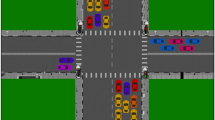Abstract
Nowadays, traffic congestion is increasingly aggravating in almost every urban area and existing traffic light controllers cannot satisfy the rising demands efficiently to handle the traffic pressure. An intelligent transportation system (ITS) aims to provide major innovations for improving the performance of a public transport system including the traffic light control systems. In this paper, we propose a fog-based distributed architecture for a dynamic traffic light control system for ITS. In the proposed architecture, the local gateway collects real-time local traffic data using a wireless sensor network at each intersection. It also gets the neighboring traffic data from the distributed fog nodes. Using this local and global traffic data, the proposed Efficient Dynamic Traffic Light Control algorithm for Multiple (EDTLCM) intersections calculates the optimal green light sequence and duration (that maximizes the benefits), considering three objectives i) reducing the average waiting time ii) minimizing the fuel consumption and iii) maximizing the throughput. The simulation result shows that the proposed EDTLCM minimizes the waiting time, reduces fuel consumption and improves system throughput compared to the other dynamic strategies.











Similar content being viewed by others
References
Al-Khateeb K, Johari JAY (2008) Intelligent dynamic traffic light sequence using RFID. Int Conf Comput Commun Eng. https://doi.org/10.1109/ICCCE.2008.4580829
Anass R, Yassine H, Mohammed B (2016) IoT for ITS: a dynamic traffic lights control based on the Kerner three phase traffic theory. Int J Comput Appl 145(1):40–48. https://doi.org/10.5120/ijca2016910557
Askerzade IN, Mahmood M (2010) Control the extension time of traffic light in single junction by using fuzzy logic. Int J Electr Comput Sci 10(2):48–55
Bomarius F (1992) A multi agent approach towards modeling urban traffic scenario. Tech. Rep. RR-92-47, DFKI-GmbH, Kaiserslautern, Germany
Bonomi F (2011) Connected vehicles, the internet of things, and fog computing. In: 8th ACM international workshop on vehicular inter-networking (VANET), Las Vegas, pp 13–15. https://www.sigmobile.org/mobicom/2011/vanet2011/program.html
Bonomi F, Milito R, Zhu J, Addepalli S (2012) Fog computing and its role in the internet of things. In: Proceedings of the first edition of the MCC workshop on Mobile cloud computing, pp 13–16. https://doi.org/10.1145/2342509.2342513
Chen L-W, Chang C-C (2016) Cooperative traffic control with green wave coordination for multiple intersections based on the internet of vehicles. IEEE Trans Syst Man Cybern Syst 47(7):1321–1335
Clymer JR (2002) Simulation of a vehicle traffic control network using a fuzzy classifier system. In: Proceedings 35th annual simulation symposium, pp 285–291. https://doi.org/10.1109/SIMSYM.2002.1000165
Docker (2019) Docker inc. https://www.docker.com. Accessed Jan 2019
El-Tantawy S, Abdulhai B (2012) Multi-agent reinforcement learning for integrated network of adaptive traffic signal controllers (MARLIN-ATSC). IEEE Trans Intell Transp Syst pp 319–326
Ezell S (2010) Intelligent transportation systems. The Information Technology and Innovation Foundation, New York
Hough J, Bahe C, Murphy ML, Swenson J (2002) Intelligent transportation systems: hel** public transit support welfare to work initiatives. Upper Great Plains Transportation Institute. https://www.ugpti.org/resources/reports/downloads/mpc02-131.pdf
INRIX (2019) Inrix global traffic scorecard. http://inrix.com/scorecard/. Accessed on 12 April 2019
Li Z, Al Hassan R, Shahidehpour M, Bahramirad S, Khodaei A (2017) A hierarchical framework for intelligent traffic management in smart cities. IEEE Trans Smart Grid 10(1):691–701
Little JD (1961) A proof for the queuing formula L= w. Oper Res 9(3):383–387
Moalla D, Elkosantini S, Darmoul S (2013) An artificial immune network to control traffic at a single intersection. In: Proceedings of the 2013 international conference on industrial engineering and systems management (IESM), pp 1–7
Nair BM, Cai J (2007) A fuzzy logic controller for isolated signalized intersection with traffic abnormality considered. IEEE Intell Vehicl Sympos 2007:1229–1233
Nower N, Hossan S (2017) Efficient dynamic traffic light control for ITS. In: Proceedings of the second international conference on internet of things, data and cloud computing, pp 1–7. https://doi.org/10.1145/3018896.3056807
Pacelli MJ, Messer CJ, Urbanik T (2000) Development of an actuated traffic control process utilizing real-time estimated volume feedback. Report No.FHWA/TX-01/1439-10. Dept. of Transportation, Texas
Pappis CP, Mamdani EH (1977) A fuzzy logic controller for a traffic junction. IEEE Trans Syst Man Cybern 7(10):707–717
Schrank D, Eisele B, Lomax T, Bak J (2015) 2015 urban mobility scorecard. Texas A&M Transportation Institute, College Station
Stojmenovic I (2014) Fog computing: a cloud to the ground support for smart things and machine-to-machine networks. In: 2014 Australasian telecommunication networks and applications conference (ATNAC), pp 117–122. https://doi.org/10.1109/ATNAC.2014.7020884
Stojmenovic I, Wen S (2014) The fog computing paradigm: scenarios and security issues. In: 2014 federated conference on computer science and information systems, pp 1–8
Sumo (2019) Simulation of urban mobility. http://www.dlr.de/. Accessed March 2019
Sussman JS (2008) Perspectives on intelligent transportation systems (ITS). Springer, Berlin
USDOT (1996) Traffic control systems handbook. Federal highway administration, FHWA-SA-96-032, US Department of Transportation
Wen W (2008) A dynamic and automatic traffic light control expert system for solving the road congestion problem. Expert Syst Appl 34(4):2370–2381
Zhou B, Cao J, Wu H (2011) Adaptive traffic light control of multiple intersections in WSN-based ITS. In: 2011 IEEE 73rd vehicular technology conference (VTC Spring), pp 1–5
Zhou B, Cao J, Zeng X, Wu H (2010) Adaptive traffic light control in wireless sensor network-based intelligent transportation system. In: 2010 IEEE 72nd Vehicular technology conference-fall, pp 1–5
Zhou Y, Zhang D, **ong N (2017) Post-cloud computing paradigms: a survey and comparison. Tsinghua Sci Technol 22(6):714–732
Author information
Authors and Affiliations
Corresponding author
Additional information
Publisher's Note
Springer Nature remains neutral with regard to jurisdictional claims in published maps and institutional affiliations.
Rights and permissions
About this article
Cite this article
Hossan, S., Nower, N. Fog-based dynamic traffic light control system for improving public transport. Public Transp 12, 431–454 (2020). https://doi.org/10.1007/s12469-020-00235-z
Accepted:
Published:
Issue Date:
DOI: https://doi.org/10.1007/s12469-020-00235-z




